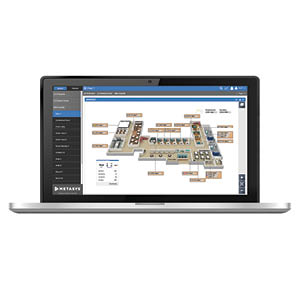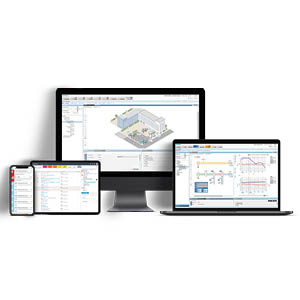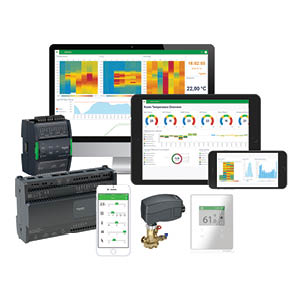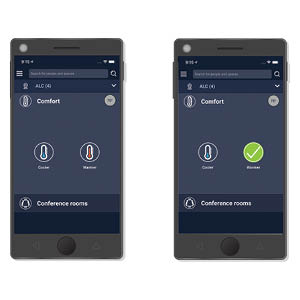Building automation expands for hospitals

Image from Johnson Controls
Building automation system (BAS) providers are tasked with helping health care facilities find ways to reduce their costs, increase staff efficiency and provide secure operational systems, all while ensuring resiliency and redundancy.
Many challenges
Hospitals pose many challenges to BASs, ranging from external factors such as changing regulatory requirements to internal factors such as resource constraints and staff shortages.
Aging infrastructure, including outdated legacy system equipment and slim profit margins, mean that hospitals often lack both the digital and financial resources to support BAS initiatives, according to Drew Byrd, buildings segment leader at Schneider Electric, Boston. “A general lack of familiarity with the technology among even hospital information technology (IT) staff can create roadblocks for these deployments.”
Cybersecurity is another challenge. Security incidents can include data breaches as well as disruptions to IT operations and business functions. To combat this challenge, BAS providers must partner with hospital IT departments to understand their specific network facilities requirements, says Ken Gilbert, regional technical consultant for Automated Logic, Atlanta. “Hospitals should perform risk assessments with the assistance of BAS providers to make decisions on the network architecture and security controls, such as with defense-in-depth and incident response plans.”
The growing number of smaller, off-site facilities poses additional challenges for BAS providers. Many smaller facilities lack technical support and, even when they are within the network of a larger care provider, they may not receive proper communications or support for installing new systems within their own facility. This also poses challenges when each of these off-site facilities is running different systems, which requires a central IT team to manage logistics.
Smaller health care facilities often have a limited number of spaces that need to act as multiuse areas — ranging from patient rooms to operating rooms to imaging rooms — and quickly adapt to serve various use cases. “A well-integrated BAS helps by providing the appropriate space conditions and lighting required for each use case,” says Robert Harland, Metasys brand manager at Johnson Controls, Milwaukee. “Also, these types of buildings don’t always have an experienced or fully dedicated facilities staff, so having remote access to these buildings is important.”
Many health systems are acquiring smaller health networks, resulting in a potpourri of BASs, according to Ayana Nathan, head of health care at Siemens Smart Infrastructure USA, Buffalo Grove, Ill. “Operationally, they have systems of various ages, little integration capabilities and limited remote access, coupled with staff shortages. Hospitals are looking for BAS providers to find innovative ways to help solve these challenges,” Nathan says. “Overall, it is difficult to find skilled facilities staff to manage these remote locations. This presents a challenge for BASs to support remote connectivity, which is difficult to achieve from a central location.”
Data collection
Data collection is a key component of the latest BASs. “Data collection provides the information needed to make thoughtful decisions about how to operate the physical plant to provide healing environments for patients in a cost-effective and sustainable manner,” Gilbert says. “The ability to identify and detect trends in data streams frequently reveals outliers and anomalies that can impact operational costs or patient and staff comfort.”
The energy budget is one of the largest costs a facilities department must manage, Gilbert says. “Thus, it is important to be able to quickly identify deficiencies and mitigate the cost impact of nonperforming equipment or systems, and to create efficiency with the maintenance and contracting teams,” he says. “Being able to trend and record environmental and equipment operating characteristics over time provides a baseline from which future analysis can be predicated against.”
Harland says that data collection allows facilities managers to tap into the foundational role that a well-integrated BAS plays in a building management strategy. A BAS collects data from not only HVAC systems, but also from fire, security, lighting, and even business and specialty systems to make informed building management decisions.
“An effective BAS will present this data in a clear, intuitive way to identify issues before they become costly repairs; seamlessly connect with cloud-hosted analytics to turn data into insights and corrective actions; and support data searching and filtering required for various compliance reporting issues,” Harland says.
Data collection is essential to improving and refining BASs, and there are three areas where it is especially important, according to Byrd:
- Reliability-centered maintenance. Health care facilities need to prioritize their workforce and capital, and data helps to remove the added stressors of unexpected maintenance demands. By adopting more connected solutions, hospitals can regulate energy resources throughout the facility, which increases efficiency, sustainability and resiliency while providing cost-cutting opportunities that won’t affect patient satisfaction.
- Centralized control. An intelligent facility orchestrates all the critical data elements that are shared across equipment, and controls the facility holistically, to keep all of these operations organized and easily accessible in one location. By integrating connected technology systems, resources on both the IT and operational technology (OT) sides can be deployed efficiently.
- Better outcomes. Hospitals are focused on improving care for patients, and that extends to their facilities. Data on outcomes and trends analysis allow facilities managers to create strategies that improve patient safety. Interoperable BAS connectivity avoids the need to acquire systems from multiple vendors. A connected system with reliable data output simplifies regulatory compliance and improves financial performance, staff productivity, safety and security.
Expanding capabilities
BAS vendors have expanded their health care-related BAS applications and functions in recent years. For example, Schneider Electric has expanded its offerings to include BAS analytics to better monitor and diagnose problems in mechanical operations and then feed those insights into computerized maintenance management systems (CMMSs) to make improvements. “Our solutions facilitate the secure exchange of data from both Schneider Electric and third-party energy, lighting, HVAC, fire safety, security and workplace management systems while leveraging digitization and big data for greater visibility,” Byrd says.
Automated Logic continues to see an increase in the diversity of delivery models of care, especially in urgent care and localized health delivery services. In response, the company has expanded its distributed and cloud solutions for enterprise applications, along with remote site monitoring and analysis. “With an increased focus on indoor air quality (IAQ), we have seen a significant demand in technologies that can communicate IAQ posture to the patient and staff community,” Gilbert says.
“These include touchscreen displays, innovative metrics and quick response (QR) codes that link to IAQ content, foster confidence in the healing environment and enhance patient outcomes,” Gilbert says. “These visualizations can be created and displayed on lobby kiosks, internet protocol links or patient devices. Machine learning and artificial intelligence (AI), along with rich analytic tool sets, allow us to monitor, report and use feedback and control loops that can act on environmental deviations.”
Siemens has expanded its BAS solutions for health care by creating more opportunities to satisfy more use cases with integrated data from operational and clinical systems. For example, its BAS solutions can give patients the ability to control their room environments and can integrate with smart beds to reduce the likelihood of patient falls. Siemens also has deployed solutions that reduce the impact of lighting on a patient’s circadian rhythm.
Health care offerings
Schneider Electric offers EcoStruxure Building Operation, a cloud-based BAS. EcoStruxure offers greater interoperability between systems running in health care facilities and allows field controllers to feed up to the cloud and reduce server loads. “It also provides access to building data anytime via smartphones, tablets or laptops; visibility into large campuses and global enterprises in one convenient view; and time- and labor-saving features,” Byrd says.
Automated Logic has developed the MyWay mobile app, which extends the power of the WebCTRL BAS from the facilities manager to building occupants, putting them in control of their own comfort. The app is designed to provide staff with touchless entry at all security points, adjustment of room temperature and lighting scenes, and booking of conference rooms in real time. “Building occupants now can personalize and streamline their everyday experience in the buildings where they work,” Gilbert says. “From temperature control to conference room bookings, the MyWay mobile app empowers occupants by connecting them directly to their building environment.”
Johnson Controls offers Metasys Release 11.0, which includes a new fault detection and fault triage feature suite that identifies building system-related faults in order of severity, and provides suggested possible causes and corrective actions to help operators quickly identify and troubleshoot issues to keep systems running optimally and building occupants comfortable. It also features FIPS 140-2 Level 1 compliance for Metasys network engines and application servers, which provides a strong cybersecurity technique to help prevent unauthorized access to customer systems and data.
In addition, the expansion of the Metasys next-generation hardware platform includes a new supervisory network controller series model with an onboard interface. It gives operators the ability to quickly monitor equipment status, view alarms, see trends, issue overrides, and change setpoints and parameters.
Powermanager from Siemens is a Desigo CC extension module that delivers real-time monitoring and analysis throughout the electrical infrastructure of a facility. An extension module of the Siemens Desigo CC BMS, it integrates a building’s infrastructure and electrical monitoring into one system. This enables facilities managers to promote actionable responses, simplify root cause analysis, develop key performance indicators for tracking and reporting, and manage alarming.
Another upgrade, Siemens’ Desigo CC with Advanced HL7 integration capability, can help facilities managers reduce clinical workloads and improve operational performance. One example of this integration uses admission, discharge and transfer data to place patient rooms in occupied or unoccupied mode, which ensures consistent arrival experiences. It also can be used to incorporate surgical scheduling information, resulting in reduced clinical workloads and improved energy savings.
Technology moves forward
Byrd predicts that BASs will continue to see new advances in mobile applications and touchless communications options. This will make them faster and easier to operate in hospital environments, while minimizing contact and potential contamination.
For his part, Gilbert sees significant growth in digital services and the ability to aggregate massive data sets through machine learning and AI. “This will produce site-specific, innovative strategies that will mitigate waste, increase efficiency and extend equipment life cycles.”
BAS integration needs will continue to increase, Nathan says, resulting in more interaction and partnering with IT organizations. “To drive operational efficiency, there will be more integration between OT and IT systems, expanding the ability to integrate and manage more operational components of the hospital.”
Harland notes that a more cyber-secure version of BACnet was recently approved. “This version will gain more popularity in BAS device networking applications in hospitals.”
Neal Lorenzi is a freelance writer and regular contributor based in Mundelein, Ill.

INFORMATION RICH
Metasys presents information from multiple building systems to help hospital facilities teams quickly identify and troubleshoot issues. Johnson Controls

TAKING CHARGE
Desigo CC with the Powermanager extension module allows facilities managers to promote actionable responses, simplify root cause analysis, and develop key performance indicators for tracking and reporting. Siemens

URGENT ACTION
EcoStruxure Building Operation provides actionable insights to better manage buildings, improve engineering efficiency, and meet cybersecurity and compliance demands. Schneider Electric

COMPLETE CONTROL
The MyWay app provides a touchless experience for hospital staff to adjust room temperatures in real time. Automated Logic
Neal Lorenzi is a Mundelein, Ill.-based contributor to Health Facilities Management.




